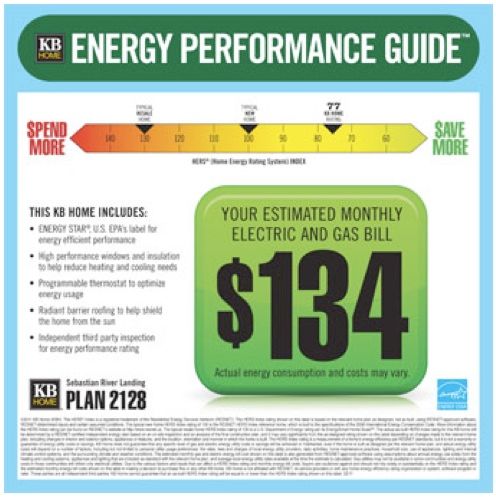
The consumer market is already ripe with monitoring gadgets, software tools, and strategies to help homeowners track and tame their energy use. But the thing is, the effectiveness of each of them – including the ones that rely heavily on peer pressure – ultimately depends on one big, scary variable: occupant behavior.
So maybe there is something to be said for knowing what you’re getting into, energy efficiency-wise, before you actually buy a new home. That seems to be at least part of the rationale behind the KB Home Energy Performance Guide, or EPG, which was introduced this week and is intended to provide prospective homebuyers with an estimate of average monthly energy costs. The estimated costs are calculated using the home energy rating protocol known as the HERS Index rating, which is based on an analysis of the building’s design and performance, and on local utility rates.
The company says EPGs will be posted in all KB model homes starting this month. The HERS Index uses as its reference a comparable home built to the specifications of the 2006 International Energy Conservation Code, which would score 100 on the HERS rating scale. KB Home notes that it builds its homes to meet or exceed the Energy Star standard – which means they would score significantly lower than 100 (because they use less energy) in a HERS evaluation.
The beginnings of a green rollout
Some observers were quick to predict that, like miles-per-gallon stickers on new cars, the EPGs won’t dramatically boost sales or mean much to many buyers. On the other hand, why not give it a shot? For the cost of hiring a HERS rater – who is certified by Residential Energy Services Network, the home-performance ratings agency, to analyze design plans, run home-performance tests onsite, and calculate the energy efficiency of the buildings tested – it probably will turn into a decent marketing tool for KB. The homebuyers inclined to pay attention to energy costs are likely to find an average-usage estimate helpful, while those whose priorities point elsewhere will be busy comparing countertops, floor finishes, and faucet fixtures.
KB Home has already attracted attention for its GreenHouse, a prototype designed to operate at net zero energy, and KB’s chief executive, Jeff Mezger, told the Wall Street Journal that the EPG is actually just one part of a larger green-initiative rollout.
It also seems likely that EPG stickers will make their way into homes offered by other big builders. Steve Baden, executive director of RESNET, noted recently that the agency has been forging similar alliances with other major homebuilders, and that Pulte Group could be among the next to adopt the EPG.
Fine Homebuilding Recommended Products
Fine Homebuilding receives a commission for items purchased through links on this site, including Amazon Associates and other affiliate advertising programs.

Handy Heat Gun

Affordable IR Camera

8067 All-Weather Flashing Tape

One of KB Home’s Energy Performance Guide labels, whose monthly energy-cost estimate is, in this case, based on a design plan for the company’s Sebastian River Landing development, in Sebastian, Florida, and on local utility rates.



























View Comments
Hallelujah,
This is what I've been been talkin' 'bout:
http://greenbuildingindenver.blogspot.com/2011/02/finally-consumer-friendly-home-energy.html
http://greenbuildingindenver.blogspot.com/2010/10/leed-for-homes-rating-system.html
While I agree in principle with posting an 'energy efficiency rating' on a new home, this looks like a marketing gimmick by KB Homes and will probably lead to confusion for most home buyers. Why? Lets say for example that Ford, GM and Chrysler decide to use the EPA system to rate the cars they make on a 'miles per gallon' basis--like most every other car manufacturer. Now say Toyota decides to market their cars by advertising a 'cost per month' or 'annual gasoline cost'... The EPA's mpg rating system is already well established and most people are already familiar with it. We already have a well established HERS rating system. I can already anticipate the questions from home buyers: Whats the difference between a HERS number and the EPG number? All the information that makes it easy to compare 'apples-to apples' is already in the HERS rating. The estimated annual utility cost is already included with the HERS rating and is adjusted for the local utility rates. The EPG actually give the potential buyer LESS information than a HERS rating. It makes it harder to compare shopping for a house in Denver with a house in say North Dakota, or even a new house in Denver built by another home builder that doesn't use the "EPG" rating system. The "EPG" looks like a marketing tool which gives the APPEARANCE that a KB Home is green or efficient without giving the potential buyer a way to compare that home all the others on the market that may have a HERS rating. I say lets stick with the HERS rating...
I think this is a lot of PR from KB Home to try and get some publicity and look like they're setting some sort of energy standard in the new home building industry. I can tell you from first hand experience that KB Home cannot even insulate an attic properly to code. Our attic only had about half the blown in insulation it was supposed to have and the entire other side had absolutely no insulation. It just makes me think a lot of this energy efficiency stuff KB Home is pushing is nothing more than a bunch of hype. They also claim they spray foam gaps to tightly seal their new homews and show videos on youtube showing that they do this. We also had outdoor smells coming in from underneath baseboards all over, obviously KB Home didn't spray foam the gaps to help tightly seal the home like they claim either.
Here's more information on our experience with KB Home . . .
http://www.kbhomeproblems.com